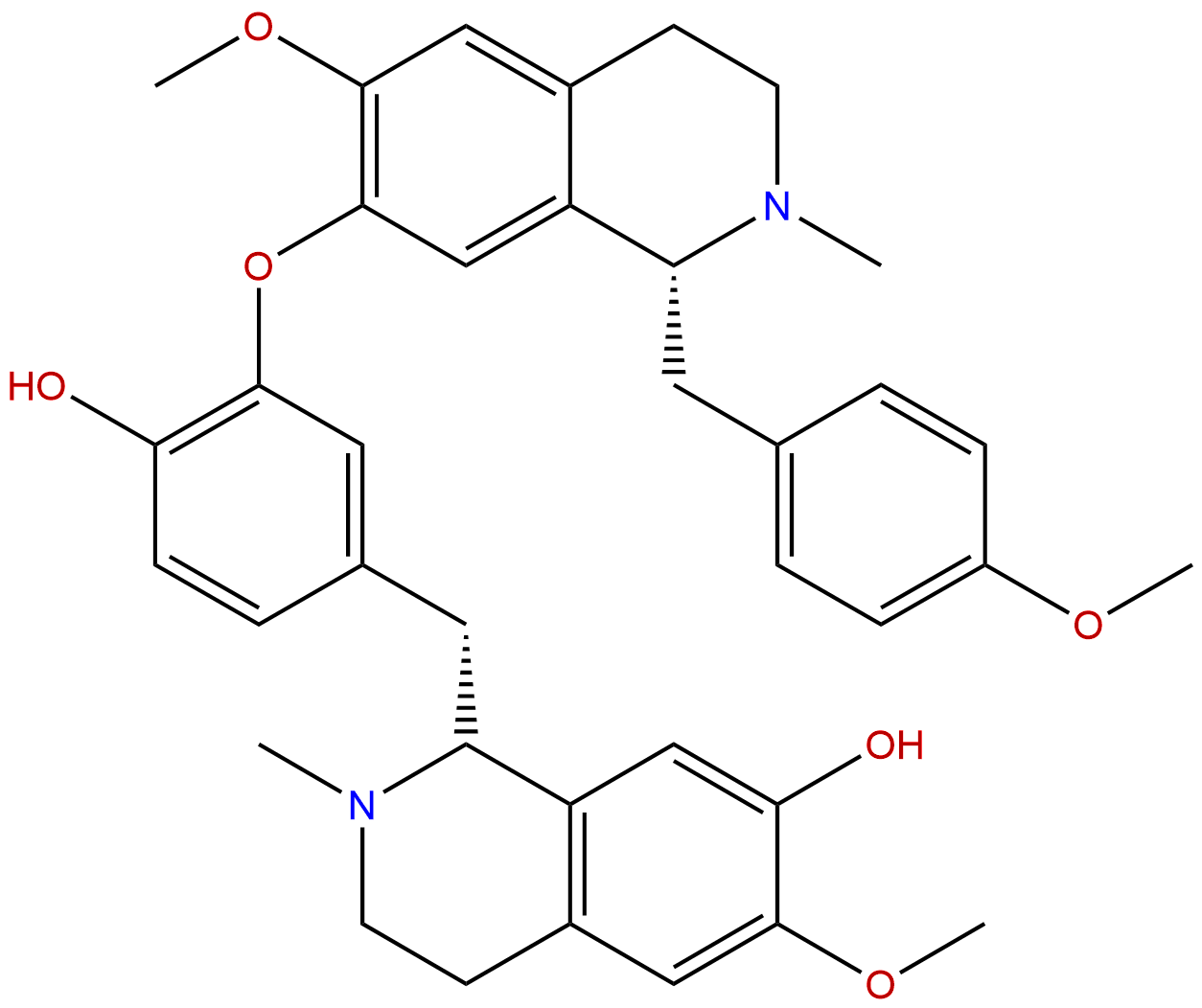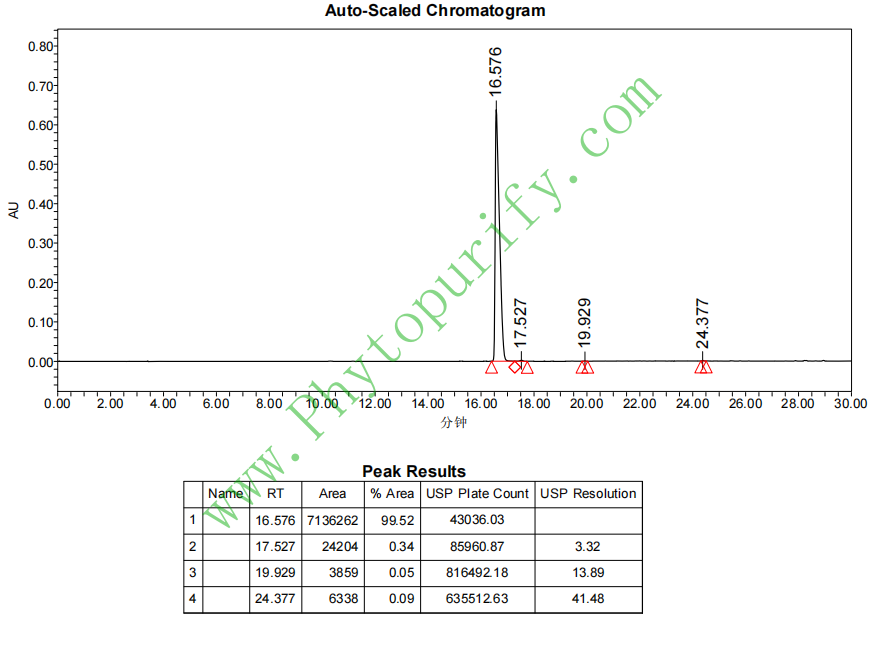
IsoliensinineCAS No.:6817-41-0 |
||||||||||
 |
|
|
||||||||

| Catalogue No.: | BP0786 |
| Formula: | C37H42N2O6 |
| Mol Weight: | 610.751 |
| Botanical Source: | Nelumbo nucifera Gaertn. |
Synonym name:
Catalogue No.: BP0786
Cas No.: 6817-41-0
Formula: C37H42N2O6
Mol Weight: 610.751
Botanical Source: Alkaloid from Root of Cissampelos mucronata an the seed embryo of Nelumbo nucifera (East Indian lotus) (Nelumbonaceae)
Purity: 95%~99%
Analysis Method: HPLC-DAD or/and HPLC-ELSD
Identification Method: Mass, NMR
Packing: Brown vial or HDPE plastic bottle
Can be supplied from milligrams to grams.
For Reference Standard and R&D, Not for Human Use Directly.
Inquire for bulk scale.
Description:
Isoliensinine has anti-cancer, anti-fibrosis, anti-proliferative, antioxidant, and anti-inflammatory activities, it inhibited TNF-alpha and TGF-beta 1; decreased the overexpression of growth factors Platelet-derived growth factor (PDGF)-beta, basic fibroblast growth factor (bFGF), proto-oncogene c-fos, c-myc and hsp70; and activated ROS and p38 MAPK/JNK .
References:
Sci Rep. 2015 Jul 29;5:12579.
Isoliensinine induces apoptosis in triple-negative human breast cancer cells through ROS generation and p38 MAPK/JNK activation.
Isoliensinine, liensinine and neferine are major bisbenzylisoquinoline alkaloids in the seed embryo of lotus (Nelumbo nucifera), and exhibit potential anti-cancer activity. Here, we explored the effects of these alkaloids on triple-negative breast cancer cells and found that among the three alkaloids Isoliensinine possesses the most potent cytotoxic effect, primarily by inducing apoptosis.
METHODS AND RESULTS:
Interestingly, Isoliensinine showed a much lower cytotoxicity against MCF-10A, a normal human breast epithelial cell line. Further studies showed that Isoliensinine could significantly increase the production of reactive oxygen species (ROS) in triple-negative breast cancer cells, but not in MCF-10A cells. The Isoliensinine-induced apoptosis could be attenuated by radical oxygen scavenger N-acetyl cysteine, suggesting that the cytotoxic effect of Isoliensinine on cancer cells is at least partially achieved by inducing oxidative stress. We found that both p38 MAPK and JNK signaling pathways were activated by Isoliensinine treatment and contributed to the induction of apoptosis. Furthermore, inhibitors or specific siRNAs of p38 MAPK and JNK could attenuate apoptosis induced by Isoliensinine. However, only the p38 inhibitor or p38-specific siRNA blocked the elevation of ROS in Isoliensinine-treated cells.
CONCLUSIONS:
Our findings thus revealed a novel antitumor effect of Isoliensinine on breast cancer cells and may have therapeutic implications.
Yao Xue Xue Bao. 2005 Feb;40(2):105-10.
Effects of isoliensinine on proliferation of porcine coronary arterial smooth muscle cells induced by phenylephrine.
To investigate the inhibitory effects and mechanism of action of Isoliensinine (IL) on the proliferation of porcine coronary arterial smooth muscle cells (CASMCs) induced by phenylephrine (Phen) and its mechanisms of action.
METHODS AND RESULTS:
MTT assay, immunohistochemical method and Western blotting were adopted. IL (0.03 - 3 micromol x L(-1)) could inhibit the CASMCs proliferation induced by Phen (0.1 micromol x L(-1)) in a concentration-dependent manner. IL (0.1 micromol x L(-1)) antagonized Phen-induced overexpression of PDGF-beta and bFGF from 0.545 +/- 0.026 and 0.47 +/- 0.03 to 0.458 +/- 0.019 and 0.376 +/- 0.017 (P < 0.01 , P < 0.01). IL (0.1 micromol x L(-1)) also decreased c-fos, c-myc and hsp70 overexpression induced by Phen from 0.57 +/- 0.04, 0.44 +/- 0.04 and (173 +/- 36)% to 0.46 +/- 0.05, 0.372 +/- 0.021 and (115 +/- 35)% respectively (P < 0.01, P < 0.01, P < 0.01).
CONCLUSIONS:
IL exerted antiproliferative effect on CASMCs induced by phenylephrine, and its mechanisms were related to decrease the overexpression of growth factors (PDGF-beta, bFGF), protooncogene (c-fos, c-myc) and hsp70.
Planta Med. 2005 Mar;71(3):225-30.
Inhibitory effects of isoliensinine on bleomycin-induced pulmonary fibrosis in mice.
The effects of Isoliensinine (IL), a bisbenzylisoquinoline alkaloid extracted from the Chinese traditional medicine seed embryo of Nelumbo nucifera Gaertn., on bleomycin (BLM)-induced pulmonary fibrosis in mice were investigated.
METHODS AND RESULTS:
Seventy-two male Kungming mice were divided randomly into eight groups as BLM-IL10, BLM-IL20, BLM-IL40, BLM-Sal, Sal-IL10, Sal-IL20, Sal-IL40 and Sal-Sal groups. BLM (0.1 mg in 0.05 ml saline per animal, once) or saline (0.05 ml per animal, once) was applied intratracheally, and IL (10, 20, 40 mg/kg) or saline was administered orally 3 times per day in the appropriate groups. Animals were sacrificed 14 days after intratracheal treatment. Lung tissue and serum superoxide dismutase (SOD) activity and malondialdehyde (MDA) levels, tumor necrosis factor alpha (TNF-alpha) and transforming growth factor beta 1 (TGF-beta (1)) were determined by biochemical measurements and immunohistochemistry. BLM treatment resulted in a significant increase of the hydroxyproline content and an obvious lung histological injury as compared to the Sal-Sal group. Administration of IL remarkably suppressed the increase in hydroxyproline content and abated the lung histological injury induced by BLM. There was a decrease in SOD activity and an increase in MDA level in lung tissue and serum in the BLM-Sal group (p < 0.01 , p < 0.01, vs. Sal-Sal group, respectively). And IL could obviously enhance the SOD activity and decrease the MDA level in a concentration-dependent manner. Moreover, IL also significantly inhibited the overexpression of TNF-alpha and TGF-beta (1) induced by BLM.
CONCLUSIONS:
These results indicated that IL possessed a significant inhibitory effect on BLM-induced pulmonary fibrosis, probably due to its antioxidant and/or anti-inflammatory activities and inhibitory overexpressing TNF-alpha and TGF-beta (1) induced by BLM.
HPLC of Isoliensinine
